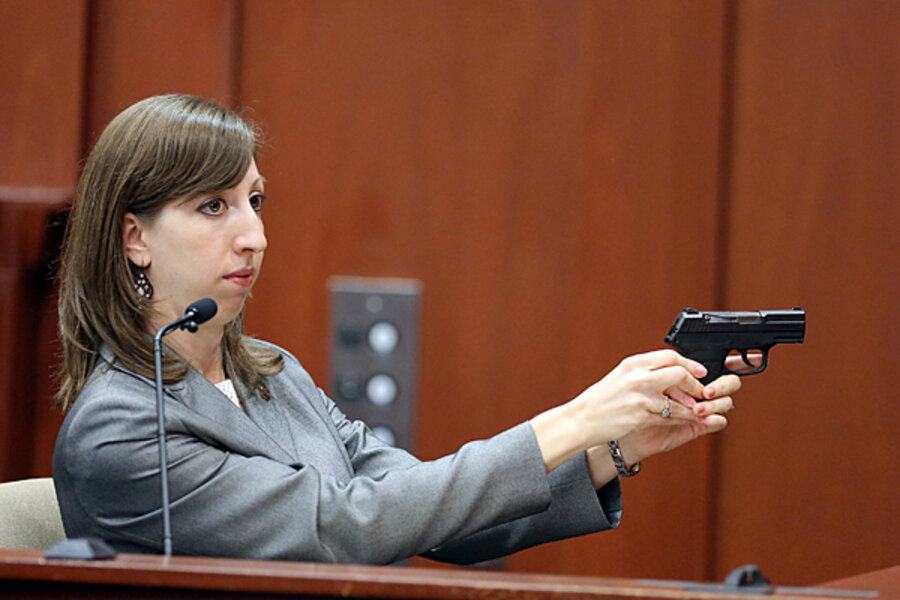Gun grab? No Trayvon Martin DNA on George Zimmerman gun, expert says
Teenager Trayvon Martin's DNA was nowhere to be found on the gun George Zimmerman used to fatally shoot him, a forensics expert testified Wednesday – a development that may cast doubt on the contention that the 17-year-old tried to grab the gun during a fight with Mr. Zimmerman in a gated community in Sanford, Fla.
The gun grab features in Zimmerman’s explanation of how he came to shoot and kill the unarmed black teenager in February 2012.
The testimony of a state forensic expert, Anthony Gorgone, provided rare bits of hard evidence in the second-degree murder case. It came amid commentators' doubts that the state has been able to prove that Zimmerman murdered Trayvon after illegally profiling him as a possible criminal.
Mr. Gorgone said he found none of Trayvon’s DNA on Zimmerman’s 9mm Kel-Tec pistol. Zimmerman has asserted, to police and to a friend, that Trayvon had grabbed for the gun before Zimmerman fired.
Mark Osterman, Zimmerman’s best friend and the author of a book defending him, testified Tuesday that Zimmerman told him on the night of the shooting that Trayvon briefly grabbed his gun as the two wrestled on the ground. Mr. Osterman said Zimmerman said to him, “somehow I broke his grip on the gun when guy grabbed between the grip and the hammer.”
Gorgone also testified he found none of Zimmerman’s DNA under Trayvon Martin’s fingernails. Zimmerman has said Travyon was beating him badly before he fired into the teenager’s chest. Nor did he find anything "that matched [Zimmerman]" on Trayvon's hoodie, including on either of the lower sleeves of the sweatshirt, he said.
Defense attorneys, for their part, got Gorgone to acknowledge that environmental conditions such as humidity or rain could have washed surfaces clean of DNA.
“Environmental factors, whether it’s raining, or there’s heat and humidity, all those factors can degrade DNA,” said Gorgone. “It chops it up into pieces.”
Heavy rain was falling Feb. 26, 2012, when Zimmerman, a neighborhood watch captain, spotted Trayvon, called 911 to report a suspicious person, and then followed him when the teenager ducked between a couple of houses in the Retreat at Twin Lakes gated neighborhood in Sanford, a city of 53,000 along Florida’s St. John’s River. After a brief fight, Zimmerman fired into Trayvon’s chest at close range, killing him. “Oh gosh, you got me,” Trayvon said, according to Zimmerman's statements to police.
Eyewitness testimony has been inconsistent concerning whether Trayvon was on top of Zimmerman, hitting him, or whether Zimmerman had the upper hand when the shot rang out.
The forensic testimony came after Judge Debra Nelson earlier Wednesday allowed testimony by two professors at Seminole County College, where Zimmerman studied criminal justice in 2010 and 2011. Though Zimmerman told Fox News’ Sean Hannity last year that he had never heard of Florida’s so-called “Stand Your Ground” self-defense law, the two professors said that law was discussed extensively in classes in which they considered Zimmerman to be a top student.
Sanford police cited the 2005 Stand Your Ground law when they declined to charge him after the shooting. During the trial, Zimmerman's lawyers have relied on a more traditional self-defense argument, saying Zimmerman, being beaten and fearing for his life, was within his rights to respond with deadly force to Trayvon’s alleged attack.
Wednesday was Day 18 of the widely watched trial, and Day 10 of testimony. The prosecution resumes its case on Friday.
The trial outcome may hang on whether jurors believe that Zimmerman, the only living direct witness, knew enough about Florida’s self-defense laws to understand which of his actions might be vulnerable to prosecution – and to craft a credible tale that would reduce those vulnerabilities in the eyes of law-enforcement officials, specifically the extent to which he was on the losing end of a fight and feared for his life.
Zimmerman was initially released by the Sanford Police Department, which said it could not counter his self-defense claims despite having some questions about the story. But a special prosecutor 44 days later indicted Zimmerman for second-degree murder, for allegedly following, confronting, and then shooting an unarmed teenager for no reason other than his own suspicions.
The case is widely seen as a barometer of American race relations, the debate over liberalized gun laws, and the fairness of the criminal justice system. It also is touching upon fears of crime and strangers, and how far Americans should be able to go to defend their own neighborhoods from crime.







